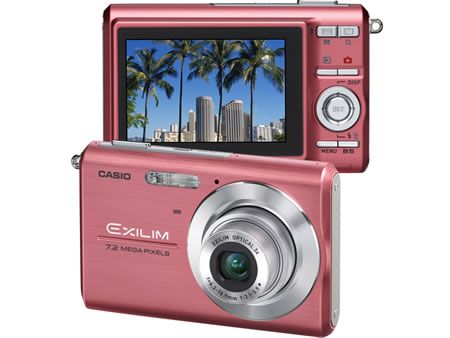The Casio EX-Z75 updates the EX-Z70 of last year but is in essence, an upgrade of that predecessor as opposed to a major overhaul. Basic kit includes a 3x optical zoom lens that provides a focal range of 38-114mm (35mm equiv.) and a stylish, slim full metal “jacket” that adds bags of panache to the machine.
Our quick take
The Casio EXILIM Zoom Z75 is, in reality, more a makeover of the Z70 than a major leap forward; that larger LCD being one of the key changes. The picture quality is good though and the addition of that larger screen and widescreen capture both for stills and movies adds a little zap to its snapping abilities.
The competitive price and nice looks should also ensure the new model is one keenly contesting the increasingly crowded marketplace and is certainly worth a look.

Casio Exilim EX-Z75 Zoom - 4.0 / 5
| FOR | AGAINST |
|---|---|
|
|
The standout feature on the new model is its 14:9 wide aspect colour screen that is excellent to use both in terms of composition and information that hogs the real estate on the camera’s back alongside the controls.
One of the features common to many of the Casio’s on the market, and this one, is the use of an information panel down the right side of the LCD. This both provides a fast check of current camera settings and, via the four-way jog dial on the back, allows you to scroll through and then reset any of the options.
The displayed information includes the number of pixels in use, flash settings, self-timer, ISO, white balance and exposure compensation. In short, all the key options you’ll need most often.
The user friendliness of the Z75 extends to the many scene modes on offer, accessed through the “BS” button on the back, which sits next to the menu button. From here no less than 33 scene modes are available to use from party, landscape, macro and a splashing water mode to food, pet and underwater settings.
Other controls include a sliver-like shutter release on the top plate and a tiny, recessed on/off button. On the back plate, besides the aforementioned controls, you have the dual zoom controls for the lens, a play back and capture mode button and a large, “SET" button sat centrally within the four-way jog button.
In terms of performance, the start up is fast at well under a second while shutter lag is almost non-existent with a blisteringly fast 0.002 sec delay. High-speed image playback offers a 100 image in 10-second playback performance and USB2 connectivity keeps PC communication speeding along as well. Lens zoom speed is good at around one second to go from the wide to full zoom end of the focal range.
The rechargeable lithium ion battery allows for up to 200-shots according to Casio’s tests. VGA movie recording is possible and the Z75 but even better is 512 x 384-pixel movie mode at 30fps, for widescreen style movie capture.
The Z75 also allows up to 100-minutes of continuous movie recording – with sound – dependent on the capacity of the SD, SDHC, MMC or MMC Plus card you’re using.
Another nice touch is the high speed built-in flash unit that enables up to three frames to be snapped with flash every second and there’s a nice flash assist function too.
The Z75’s styling remains as slim as its Z70 predecessor and makes the camera extremely pocketable indeed. It may be slim but the control lay out is neat with controls placed in relevant pairs for example. While this means they are usable, they are quite slim and that slim line button design also means anyone with fatter fingers may have some control nimbleness issues, as did I. However, the lack of an optical viewfinder – though common on many such digital cameras today – may put some off.
Picture taking performance is usually where the proverbial pudding is proven, and the Z75’s focus and metering system both work well. Detail is well captured at lower ISOs with sensitivity running between ISO 50, 100, 200 and ISO 400.
Images shot at the highest quality setting (Fine JPEGs) and ISO 50 are very clean and noise free with minimal processing to remove noise making the most of the detail. Over ISO 200, noise is evident and at ISO 400, it’s very obvious, with detail affected by noise processing.
There’s slight purple and red pixel fringing around high contrast areas as well, which just indicates the sensor’s pixel size is at the limit of the lens performance and that of the EXILIM processing engine used.
Colour is otherwise excellent and while you may find the flash being needed more often due to a more modest set of sensitivity settings, the upside is noise is less problematic.
The Casio Anti Shake DSP processing helps to reduce motion blur and camera shake by upping the sensitivity and shutter speed, but it not an optical stabilising system, so all that happens is noise is enhanced as the sensitivity is boosted.
Despite these drawbacks, the Z75’s image quality is pretty good, certainly suitable at the target market of those wanting a stylish and uncomplicated snapping machine.
To recap
Casio’s latest EXILIM has a few neat new features, and image quality isn’t bad either. It even comes in four colours...
